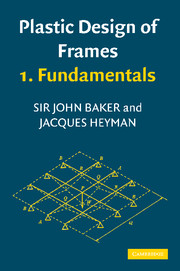3 - THE TOOLS OF PLASTIC DESIGN
Published online by Cambridge University Press: 06 July 2010
Summary
The beams and portal frames discussed so far have been simple enough for them to be analysed by a ‘direct’ approach. Bending-moment diagrams were easy to draw, and the number of possible mechanisms of collapse was small, so that the complete behaviour of the frames in the various examples could be visualized readily. As the structure under examination becomes more complex, however, the difficulties of the direct approach increase very rapidly. The choice of collapse mechanisms is wide, and it becomes almost impossible to derive the correct solution immediately. In this situation it is natural to seek on the one hand simple approximate methods of analysis, and on the other some general principles against which the accuracy of the approximate methods can be measured.
The basic theorems of plastic theory will be established in this chapter, and, in setting up these basic theorems, an indication is given of ways in which approximate solutions may be derived. These, in turn, lead on to powerful techniques of practical computation, one of which, that of the combination of mechanisms, is discussed in detail in the next chapter. In establishing the principles of plastic theory the equation of virtual work is used extensively.
The equation of virtual work
The principle of virtual work is so simple as to be almost ‘self-evident’ but some surprising techniques of calculation can result from its use. Stated simply, if a body in equilibrium is given a set of small displacements, then the work done by the external loads on the external displacements is equal to the work done by the internal forces on the internal displacements.
- Type
- Chapter
- Information
- Plastic Design of Frames 1 Fundamentals , pp. 120 - 143Publisher: Cambridge University PressPrint publication year: 1969



